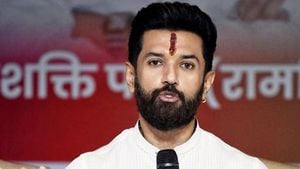New York City’s mayoral race has erupted into a fundraising showdown, with Democratic nominee Zohran Mamdani surging ahead of his rivals in both cash and polling numbers, according to the latest campaign finance disclosures and polling data. The contest, featuring political heavyweights like former Governor Andrew Cuomo and incumbent Mayor Eric Adams, has become a test of grassroots enthusiasm versus establishment muscle, and the numbers tell a fascinating story.
Between July 12 and August 18, 2025, Mamdani raised a staggering $1.05 million, more than doubling the $507,000 collected by Cuomo in the same period, as reported by POLITICO and filings from the New York City Campaign Finance Board. Mamdani’s campaign, powered by small-dollar donors, reported an average contribution of $121, highlighting the depth of his grassroots support. In contrast, Cuomo’s average donation came in at $646, and Adams’s at $770, reflecting a more traditional donor base.
But it’s not just the totals that are turning heads. The geographic breakdown of donations reveals a citywide—and even national—interest in the race. According to The New York Post, 53% of Mamdani’s recent haul, or $532,000, came from outside New York City, with $490,000 from within the five boroughs. Cuomo’s donor base was split almost evenly between inside and outside the city, and just over 52% of his contributions this period came from outside NYC, mirroring Mamdani’s own donor distribution. Sliwa, meanwhile, raised $407,000, with 66% from the city itself, and Adams pulled in $420,000, 60% of which was local.
These numbers have translated into formidable war chests for the leading candidates. As of August 23, 2025, Mamdani reported $4,392,480 in cash on hand, before accounting for matching funds. Adams followed with $3,934,924, Sliwa with $2,002,816, and Cuomo with $1,157,614. Notably, Mamdani is on track to receive up to $2.2 million in public matching funds at the upcoming Campaign Finance Board meeting, further boosting his already substantial resources. Cuomo, facing tighter fundraising rules and a complicated process for transferring state campaign funds, is hoping for a $400,000 payout in matching funds.
Cuomo’s campaign finances have drawn particular attention. After resigning as governor in 2021 following a state attorney general report that found he sexually harassed 11 women—allegations he continues to deny—Cuomo relaunched his political efforts by transferring $68,225 from his previous state-level campaign account into his city campaign. In July, his state account still held a hefty $7.5 million, but New York City’s strict fundraising regulations have limited how much he can bring over. As Cuomo spokesperson Rich Azzopardi explained to POLITICO, "Certain people wanted to transfer donations they made to the state account to the city account and, in consultation with [the NYCCFB], were permitted to on an individual basis."
Despite his past prowess as a fundraiser, Cuomo now finds himself the underdog. He’s running as an independent and trails Mamdani by double digits in most polls. An early August Siena College poll showed Mamdani leading the five-person field by nearly 20 points, and a Decision Desk HQ average put him 13 points ahead of Cuomo. The former governor has responded by reinventing his campaign style—hosting more digital town halls, using PowerPoint presentations reminiscent of his COVID-19 briefings, and adopting a more informal social media presence. He’s also appealed to Republican leaders, reportedly expecting them to urge GOP voters not to support Sliwa, in hopes of consolidating the anti-Mamdani vote.
Cuomo hasn’t pulled punches in his criticism of the frontrunner. In a Fox News appearance on August 22, he labeled Mamdani "anti-police" and "anti-corporate," adding, "A lot is going to happen between now and then. I don’t think the public even knows who the assemblyman is, what he represents, what his positions are. So I think the more they find out about him, the less they’re going to like him, and… his appeal is going to drop dramatically."
Yet Mamdani’s appeal appears to be growing, not shrinking. His platform—centered on a rent freeze, city-run grocery stores, and free childcare—has resonated with working-class voters. According to Nexstar Media, some have dubbed him the "champion" of working-class New Yorkers. If elected, he would become the city’s second democratic socialist mayor, a prospect that’s energized unions and local party leaders, though top Democrats like House Minority Leader Hakeem Jeffries and Governor Kathy Hochul have so far withheld their endorsements.
The city’s business elite remain wary of Mamdani’s left-leaning policies, especially his proposals to raise taxes to fund expanded social services like free buses and childcare. For wealthy donors hoping to block Mamdani, options are limited. The super PAC that supported Cuomo’s primary bid, Fix the City, has not yet mounted a significant effort for the general election, and Adams’s campaign has been hampered by the denial of public matching funds amid ongoing corruption allegations.
Adams, running as an independent, has insisted he won’t drop out despite trailing in the polls and facing legal battles. He recently sued the Campaign Finance Board to release millions in public funds that have been withheld due to the indictment of a close adviser in a bribery case. Meanwhile, Sliwa, the Republican nominee, has said he would only leave the race "if he’s dead," underscoring the intensity—and, at times, the absurdity—of the contest.
All candidates have agreed to a $7.9 million spending limit for the general election, a condition of the public matching funds program. Mamdani is expected to reach that cap well before November, allowing him to focus on voter outreach rather than further fundraising. In the meantime, the race has drawn national attention, with donors and activists from across the country watching closely as New York’s electorate weighs the merits of reform, experience, and ideology.
As the campaign enters its final stretch, the city finds itself at a crossroads. The financial disclosures and poll numbers paint a picture of a race shaped as much by small-dollar enthusiasm as by political calculation. With millions in play and the city’s future direction at stake, New Yorkers can expect the contest to remain fiercely competitive—and unpredictable—right up to Election Day.



